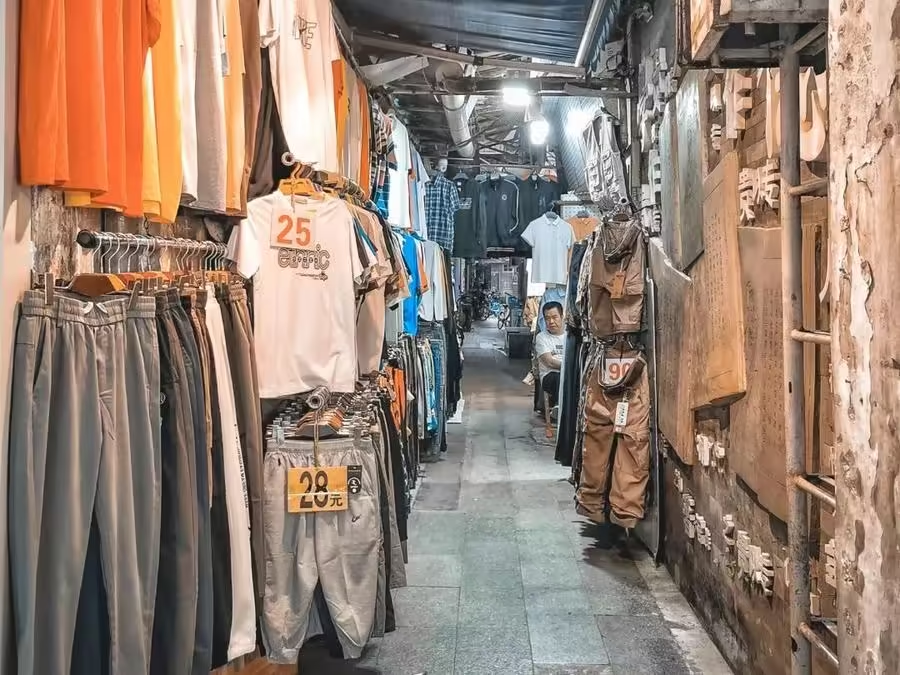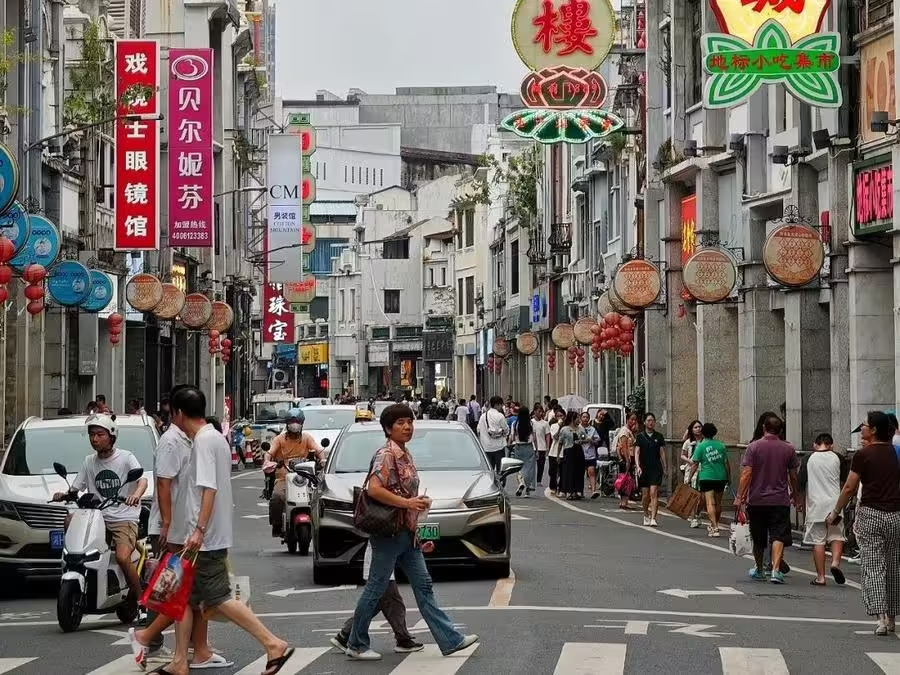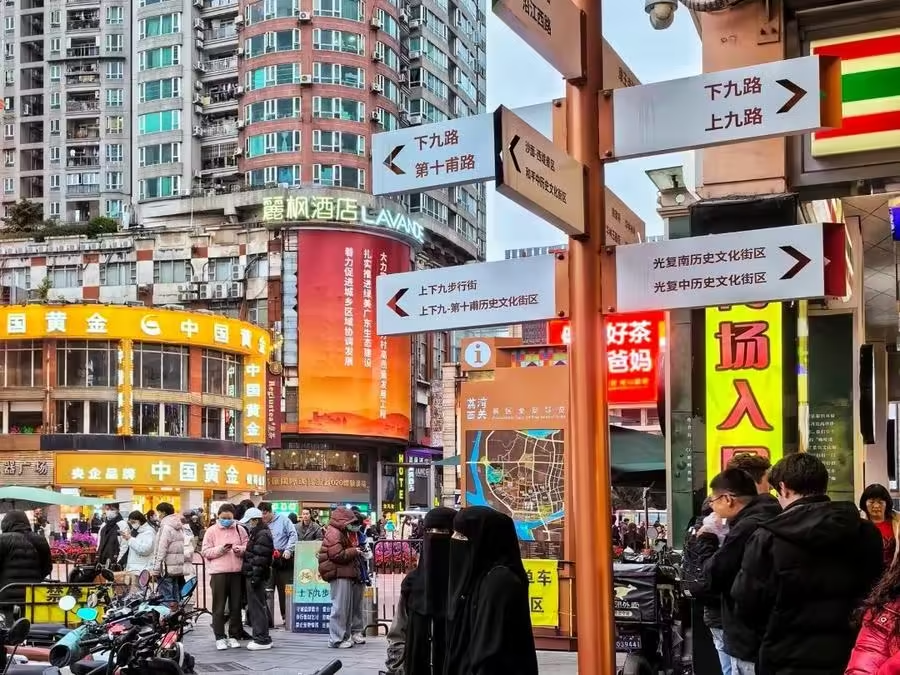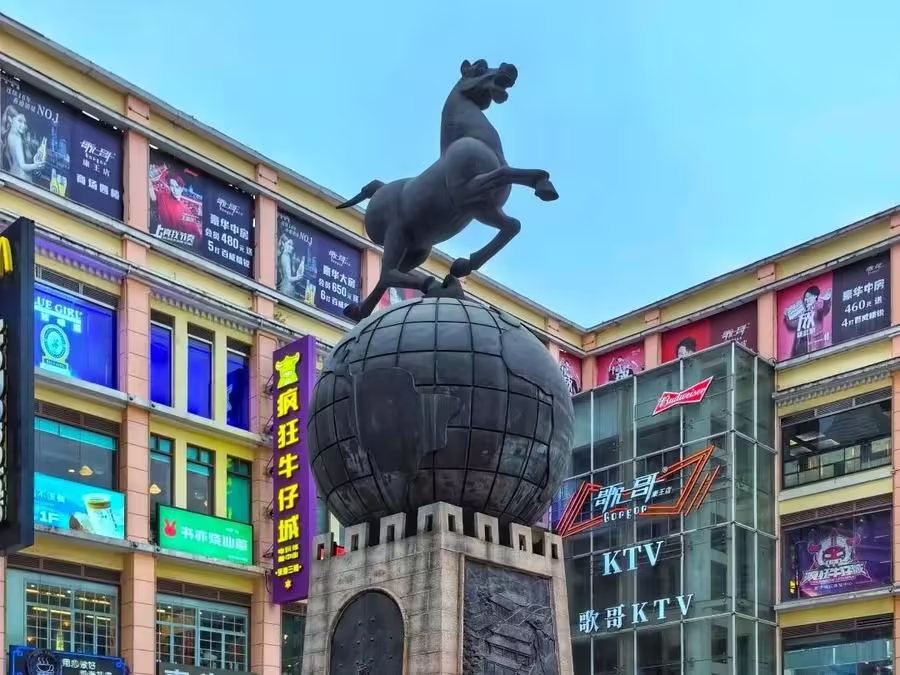Shangxiajiu Pedestrian Street (上下九步行街) is located in Liwan District of Guangzhou, Guangdong Province, an area traditionally known as Xiguan. It is one of Guangzhou’s three major historic commercial centers, stretching over 1,237 meters and featuring more than 300 shops along the entire street. The area showcases Lingnan culture, including its architectural style, cuisine, and local customs.
As early as the 620s during the Sui Dynasty, this area had already become a bustling commercial hub. In the Ming and Qing Dynasties, trade flourished with the establishment of the Huaiyuan Inn (on the southern side of today’s Xiajiu Road), the opening of Daguan River, and the rise of the Thirteen Hongs as a key port for foreign trade in Guangzhou. Merchants from various countries and regions gathered here, making it the city’s largest trade center. After a fire destroyed the Thirteen Hongs, commerce gradually shifted to the Shangxiajiu area. By the late Qing Dynasty, it became one of the most prosperous districts in Guangzhou, serving as an important trade link between China and the rest of the world.
Table of Contents
- Basic Information
- Location and Transportation
- Highlights of Shangxiajiu Pedestrian Street
- Vlog about Shangxiajiu Pedestrian Street
- History of Shangxiajiu Pedestrian Street
Basic Information
| Estimated Length of Tour | 1 – 2 hours |
| Ticket Price | Free |
| Opening Hours | 24 hours a day throughout the year |
| Telephone Number | 0086-020-81711235 |
Location and Transportation
Shangxiajiu Pedestrian Street is located at No. 6 Xiajiu Road, in the Liwan District of Guangzhou, Guangdong Province, China. It stretches between Shangjiu Road, Xiajiu Road, and Dishifu Road, forming a major commercial hub in the heart of the city’s historic Xiguan area. To get there, you can choose one of the following ways:
Bus: Take bus 61 or 530 and get off at Shangxiajiu Pedestrian Street Stop (上下九步行街站).
Metro: The closest metro station to Shangxiajiu Pedestrian Street is Hualin Temple (华林寺) on line 8. After getting out of the station from Exit E, walk about 300 meters to the south to reach the attraction.
Highlights of Shangxiajiu Pedestrian Street
Commercial Culture

As commerce along Shangxiajiu Street flourished, several specialized markets emerged in the surrounding area, forming a historical commercial network that continues to thrive today. To the east, there is the Guangfu Zhong Road wholesale paper market and sewing machine market, Guangfu Nan Road fabric market, and Yangxiang Road textile market. The Dexing Road market offers clothing accessories, while to the south, the renowned Shisanhang Road “Secondhand Clothing Street” and Shibafu Road textile market are major attractions. Also famous are the Huangsha agricultural and food market and the Qingping Chinese herbal medicine market.
To the west, the century-old Tao Tao Ju restaurant and Lianxiang Lou, both located on Dishifu Road, now part of the pedestrian street, along with many other eateries, continue to draw visitors. To the north, Changshou Road houses the professional hairdressing supplies market, goldsmith and silversmith trades, and jewelry stores. Historical streets like Xilaizheng Street (known for jade markets), Suanzhi furniture street, and Yuansheng Street’s antique market form a vast 2.5-square-kilometer commercial network, offering diverse products and catering to merchants and shoppers alike.
Architectural Culture

The traditional architecture of the Xiguan area includes Xiguan mansions, arcades (Qilou), and bamboo tube houses. Xiguan mansions, built by wealthy merchants during the late Qing Dynasty in western Guangzhou, are a distinct representation of Lingnan-style residences, reflecting the prosperity of the time. At their peak, over 800 Xiguan mansions existed, but fewer than 10 remain today. The arcades, originating from India and spreading through Southeast Asia, were introduced to South China in the early 1930s, and many can still be found along Shangxiajiu Street.
Folk Culture

While shopping on Shangxiajiu Pedestrian Street, visitors can explore nearby landmarks that embody the unique charm of Xiguan culture. These include Hualin Temple, Wuyan Well, Wen Tower, the Xiguan Mansion Preservation Area, Chen Clan Academy, Renwei Temple, and the European-style Shamian Island. Almost every street and alley on the pedestrian street has a rich history or legend, such as Wenlan Lane on Xiajiu Road, which echoes the past of the “Wenlan Academy” founded by wealthy merchants of the Thirteen Hongs. Zhanlu Straight Street on Dishifu Road preserves the former residence of the “Lingnan Art Garden,” once established by a master of the Lingnan painting school. Tao Tao Ju was historically a gathering place for Cantonese opera performers and was renowned for its cultural exhibitions like the “Xiguan Storytelling Hall” and “Frost Garden Calligraphy Exhibition.” The local tradition of performing Cantonese opera in “private troupes” adds a unique cultural flavor to the area. Additionally, the Litchi Bay Art and Calligraphy Exhibition Hall at Shifu Bookstore and the Ping An Theater, where Cantonese opera is performed, offer cultural oases on the bustling street.
Culinary Culture

Shangxiajiu Pedestrian Street is home to dozens of eateries, ranging from century-old establishments like Tao Tao Ju to nationally renowned restaurants like Guangzhou Restaurant. Visitors can also find a wide variety of “Xiguan snacks” such as Nanshin Dessert Shop, Oucheng Noodle Shop, Old Xiguan Beef Offal, and Old Xiguan Cheung Fun. Famous bakeries that produce Cantonese mooncakes, such as Lianxiang Lou, Tao Tao Ju, Quxiang Bakery, and Guangzhou Restaurant, are also clustered here. During the Mid-Autumn Festival, the mooncakes made here are sold across China and abroad, evoking a sense of nostalgia for overseas Chinese. The street also hosts restaurants offering cuisine from Hong Kong, Macau, Taiwan, and other international flavors, creating a blend of traditional and modern, local and international culinary exchanges. This vividly reflects the saying, “Eat in Guangzhou, taste in Xiguan,” highlighting the area’s rich food culture.
Vlog about Shangxiajiu Pedestrian Street
History of Shangxiajiu Pedestrian Street
Records show that as early as the 6th century, the area of Shangxiajiu began forming a commercial hub, making it one of Guangzhou’s earliest districts for cultural exchanges between China and foreign countries. During the Song Dynasty, Xiajiu Road was known as Xiuyi Lane and became the first commercial settlement in Xiguan. By the Ming Dynasty, with the excavation of the Daguan River, Xiajiu Road developed into a major commercial street in the western part of the city, eventually expanding into a network of 19 “fous” (commercial areas). The names Shangjiu Fou, Xiajiu Fou, and Dishifu Road, which are included in Shangxiajiu, originated from this structure.
During the Ming and Qing Dynasties, with the establishment of the Huaiyuan Post House (located south of today’s Xiajiu Road) for receiving foreign envoys and merchants, and the opening of the Daguan River, Shangxiajiu became a bustling center of commerce. The Thirteen Hongs, an important trading port for Guangzhou’s foreign trade, also contributed to the flourishing commercial activity. Merchants from all over the world gathered here, turning it into Guangzhou’s largest trading hub. After the Thirteen Hongs was destroyed by fire, commerce gradually moved to Shangjiu and Xiajiu Roads. By the late Qing Dynasty, this area had become the most prosperous commercial center in Guangzhou, serving as a major window for trade between China and the rest of the world.
During the Qing Dynasty, the area was home to the private gardens of wealthy merchants from the Thirteen Hongs. Xiajiu Fou, where today’s Liwan Plaza is located, was once dominated by the grand mansion of Liang Jingzhao, a prominent merchant. The mansion, stretching over hundreds of meters, was the residence of the famous Liang Jingguo family, known as “Xiajiu Liang.” Over time, the family produced several notable figures, reflecting the transition from merchant to official and scholar.
In the late Qing Dynasty, the Wenlan Academy in Xiuyi Lane, located in Xiajiu Fou, became known as the “parliament” of Guangzhou’s business community, serving as a meeting place for merchant representatives. In 1918, the Guangzhou government initiated a movement to demolish the city walls. Many of the Xiguan mansions owned by merchants were torn down, with the land subdivided and sold for development. This led to the construction of arcades, replacing the traditional structures.
In the early 1930s, the government designated three key commercial districts in Guangzhou, with Shangxiajiu being one of them. The roads were widened to 17 meters, and arcade buildings were constructed, gradually transforming the area into the vibrant commercial street it is today.


